If you’re looking for a family travel destination in northern Michigan, look no further than the Sleeping Bear Dunes National Lakeshore near the town of Glen Arbor. Voted “The Most Beautiful Place in America” by Good Morning America, the Sleeping Bear Dunes National Lakeshore offers visitors a rich history, scenic splendor, and a wide variety of recreational activities.
Contents
- Sleeping Bear Dunes Information for Visitors
- Things to Do at Sleeping Bear Dunes
- Stay at LeBear Resort in Glen Arbor!
- History and Geology of the Sleeping Bear Dunes
Sleeping Bear Dunes Information for Visitors
If you’re planning a trip into the Sleeping Bear Dunes National Lakeshore, be sure to stop by the Philip A. Hart Visitor Center in the village of Empire, where you can pick up a map and brochures, view displays, watch a movie to learn more about the natural and human history of the area, and pick up a souvenir at the gift shop. (Click here for directions.)
A park pass is required for entrance and can be purchased at the Visitor Center or other locations.
Pets are allowed on a leash in limited areas of the park, so if you’re travelling with a furry companion, be sure you check the map for pet-friendly areas.
If you’re into backcountry camping, there are miles of trails, with campgrounds located at the White Pine Backcountry Camp as well as on the Manitou Islands. Be sure to visit the National Park Service’s website for information about backcountry camping, including campground information, regulations, and how to obtain a permit.
To plan your visit to the National Lakeshore, you may want to check the National Park Services’ notices of current conditions.
Things to Do at Sleeping Bear Dunes
The Sleeping Bear Dunes National Lakeshore and surrounding area boast numerous recreational activities guaranteeing fun for the whole family. Swimming, picnicking, hiking, and biking are perfect for those warm sunny days, while canoeing, kayaking, or tubing the area’s rivers is an option for the slightly more adventurous. If you’re seeking even more thrills yet, try geocaching, kite boarding, or hang gliding over the dunes!
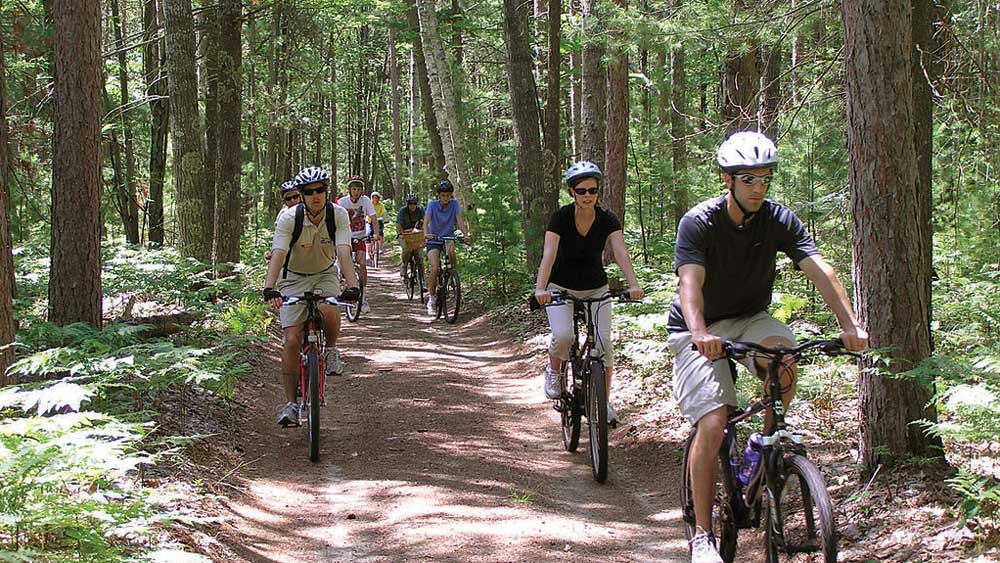
Biking in the Sleeping Bear Dunes National Shoreline (National Park Services/CC BY 2.0)
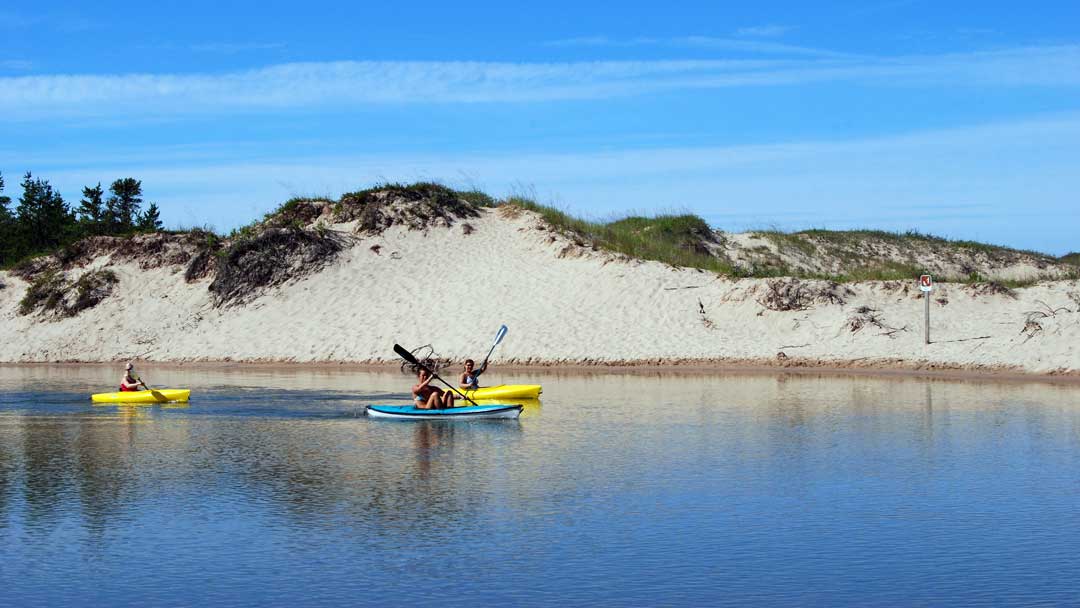
Kayaking the Platte River (National Park Service/CC BY 2.0)
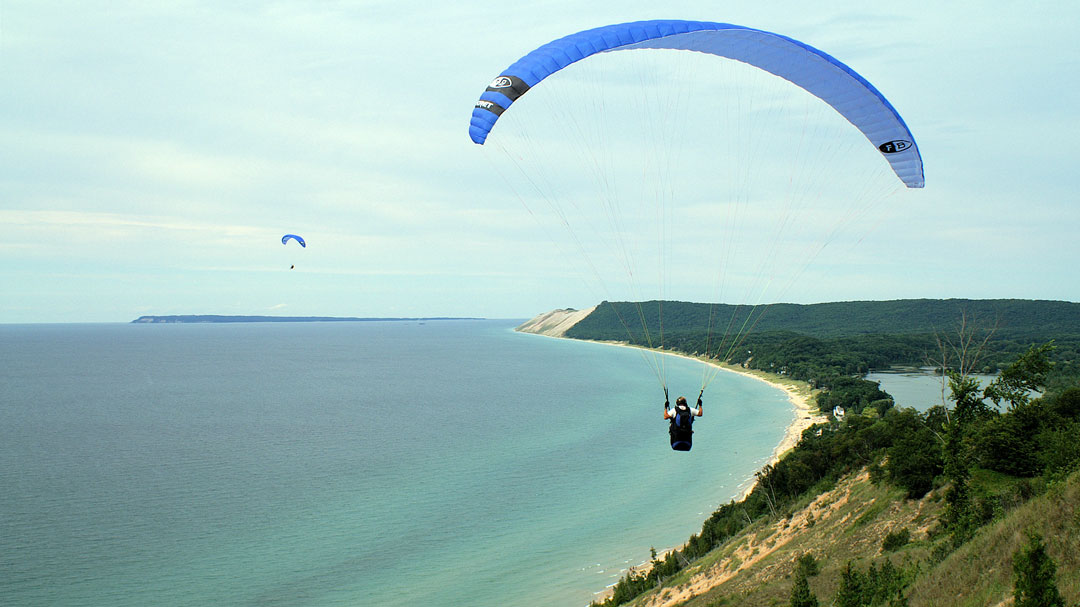
Hang gliding over the Sleeping Bear Dunes National Shoreline (National Park Services/CC BY 2.0)
No visit to the park would be complete without a stop at the Dune Climb, located four miles north of Empire on M-109. Please note that the climb can be strenuous. Once to the top, you can hike further to Lake Michigan, ascending and descending steep dunes along the way (which you’ll also have to go up and down again on your return trip). The whole trip is about 3.5 miles and may take three to four hours depending on your condition and the weather. Shoes are advisable, even if you don’t start out wearing them, because the sand can get hot and dune grass can be sharp. Also be sure to bring plenty of water and sun protection!
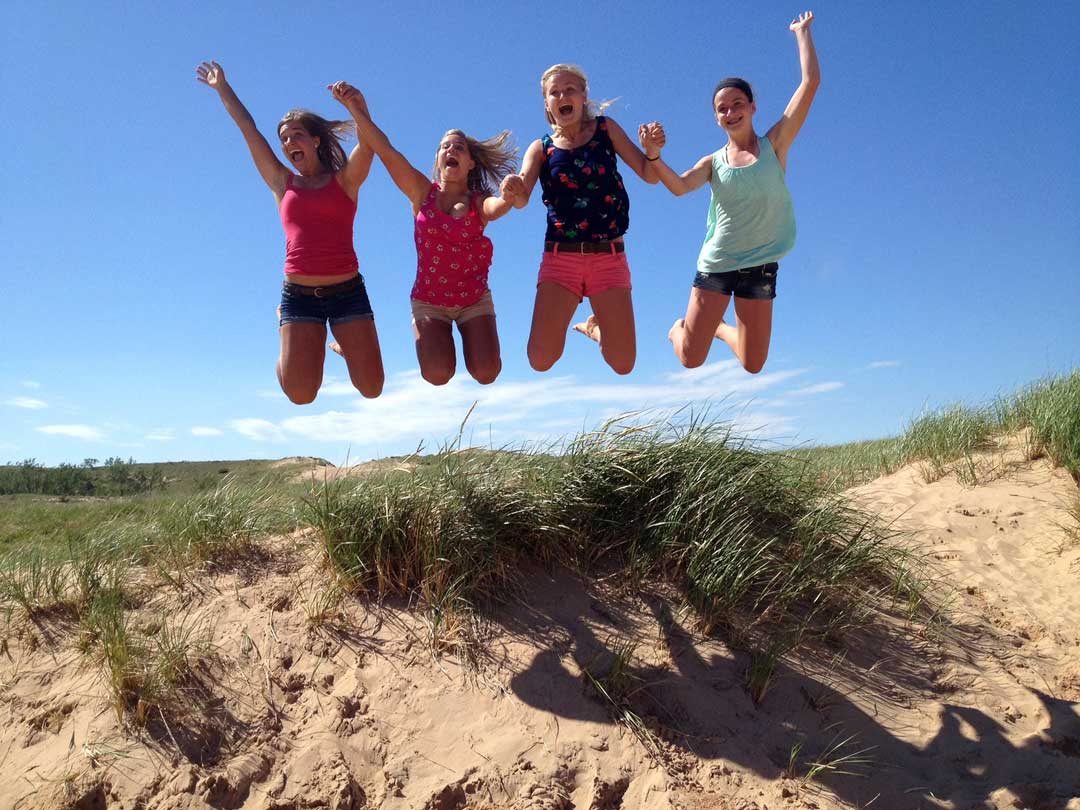
Leaping at the Dune Climb (National Park Services/CC BY 2.0)
Also a necessity is a cruise along the Pierce Stocking Scenic Drive, which loops for 7.4 miles through the forests and sand dunes, with spectacular overlooks of Glen Lakes, the Sleeping Bear Dunes, and Lake Michigan. There are numerous places to stop to take a hike or have a picnic along the way.
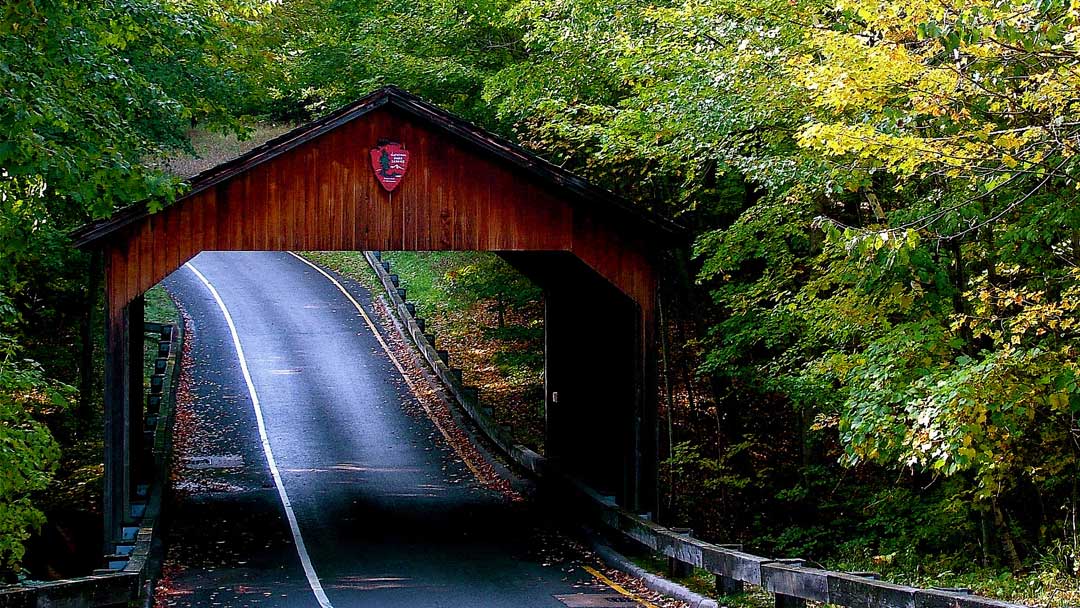
A covered bridge along the Pierce Stocking Scenic Drive (National Park Service/CC BY 2.0)
If doing the Dune Climb or hiking the numerous park trails sound too strenuous for your taste, you might opt for a more leisurely walk or bike ride along the Sleeping Bear Heritage Trail, which currently spans 22 miles between Empire and Bohemia Road near Little Traverse Lake. The trail has stretches along Glen Lake and Lake Michigan and passes through Glen Arbor and the Glen Haven historic district. (Click here for an interactive map of the Sleeping Bear Heritage Trail.)
At the village of Glen Haven, you can visit the preserved cordwood station, the cannery and boathouse museum, a blacksmith shop.
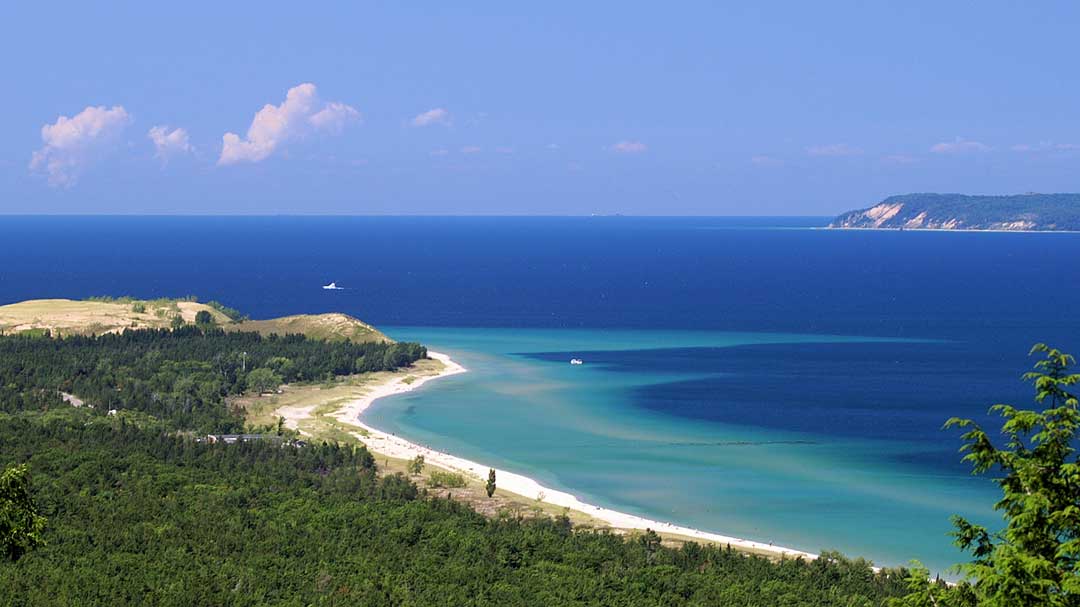
Overlooking Glen Haven in the Sleeping Bear Dunes National Lakeshore (National Park Service/CC BY 2.0)
A short distance northwest of Glen Haven is the Sleeping Bear Point Maritime Museum, where you can learn about the history of the US Life-Saving Service and Coast Guard and the maritime history of the Great Lakes. The museum is open from Memorial Day through Labor Day. During summer, at 3 pm daily, there’s a reenactment of a rescue drill using Raggedy Ann and Andy as shipwreck victims in which children are encouraged to participate. Museum staff also demonstrate the firing of the Lyle Gun, which was used to fire a rescue line from shore more than 400 yards to a ship in distress. (Click here for directions to the Maritime Musem.)
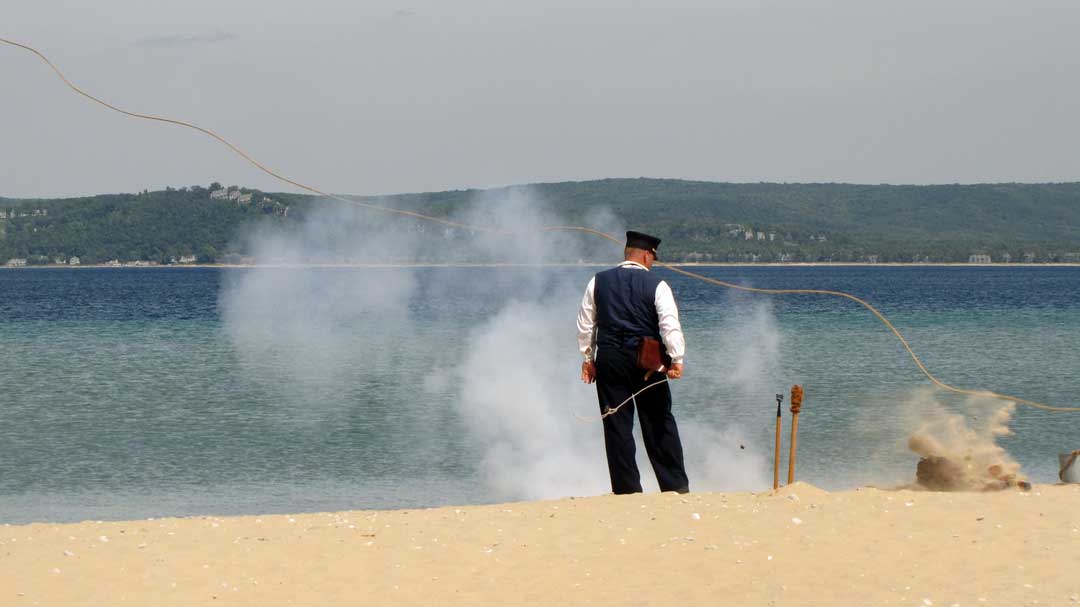
A demonstration of the Lyle Gun firing its rope-attached projectile (National Park Service/CC BY 2.0)
At the Manitou Passage Underwater Preserve, divers can view sixteen shipwrecks and seven old docks. Among the more popular dive locations are the wrecks of the Francisco Morazan, the Walter Frost, and the Alva Bradley.
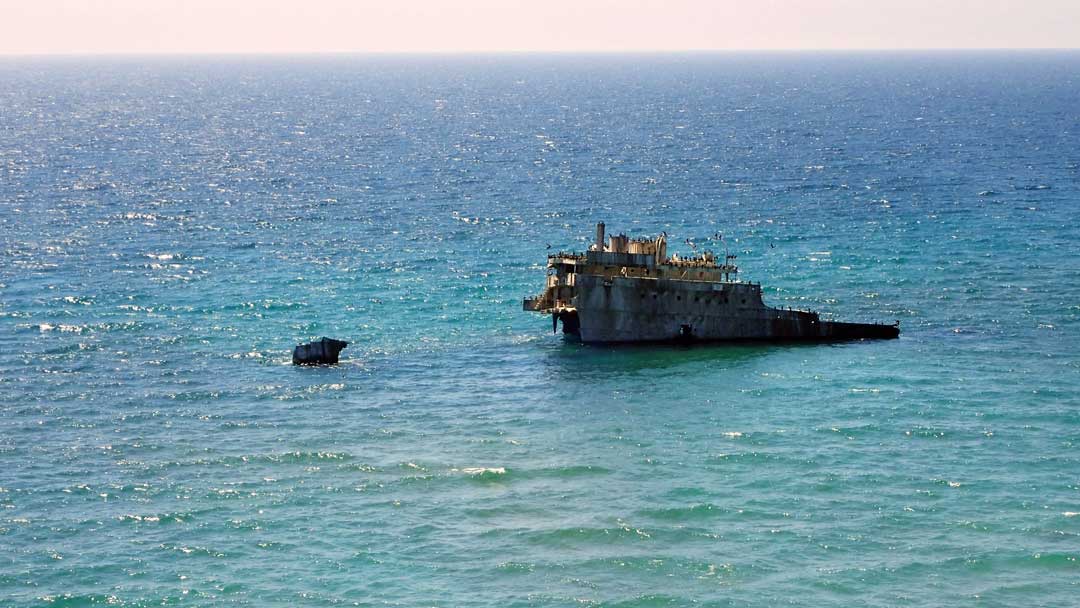
One of the numerous shipwrecks in the Manitou Passage (National Park Service/CC BY 2.0)
For additional maritime-themed adventure, visit the Point Betsie Lighthouse (more info here) or the South Manitou Island Lighthouse, which was constructed in 1871 (more info here).
At the Lanphier Observatory in Glen Arbor, enjoy stargazing using the Leelanau School’s telescope and learn about the constellations. (Click here for directions to the school.)
Visit the Port Oneida Rural Historic Area for a snapshot in time of the turn-of-the-century farms where houses and fields were passed down from generation to generation for over 100 years. Take a ride in a horse-drawn wagon, watch artists and craftsmen at work, or enjoy the annual Port Oneida Fair. (For a map and virtual tour, click here.)
While much of the area’s privately-owned agricultural land has for generations been used to grow cherries, in more recent years, growers have found the soil and climate well-suited for grapes, and the area today boasts numerous vineyards and wineries where you can taste the local flavors.
For winter adventurers, the area’s activities include downhill skiing and snowboarding, cross-country skiing, and snowshoeing. Oh, and don’t forget sledding at the Dune Climb!
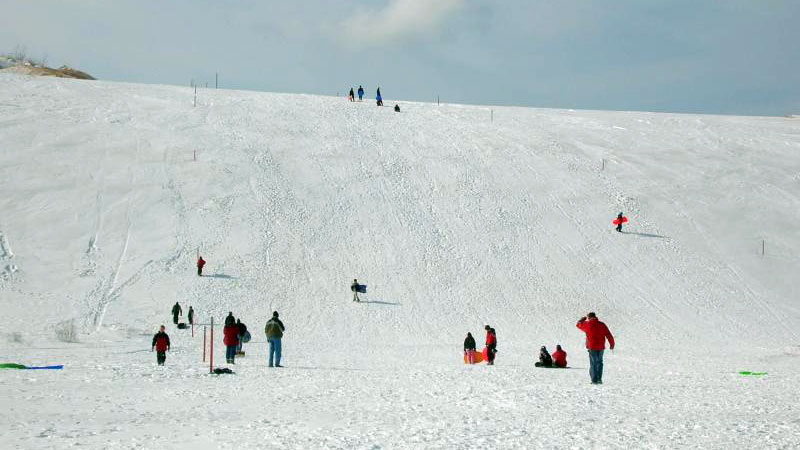
Sledding at the Dune Climb in Sleeping Bear Dunes National Shoreline (National Park Services/Public Domain)
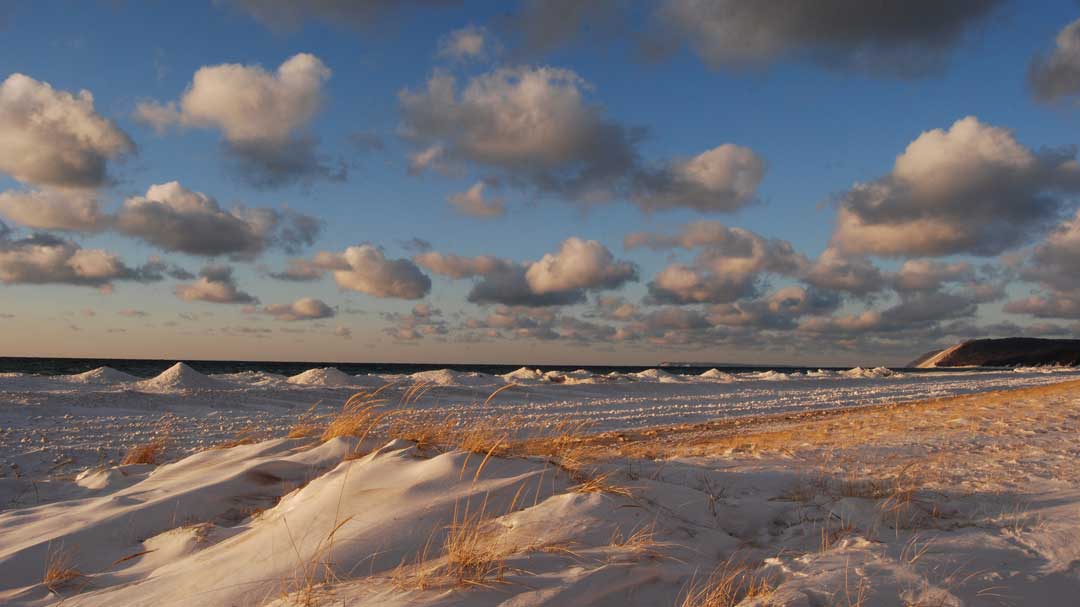
The Sleeping Bear Dunes National Shoreline in winter (National Park Services/CC BY 2.0)
For additional information to help you plan your trip, see:
- Official website of the Sleeping Bear Dunes Visitors Bureau
- Official Sleeping Bear Dunes website of the National Park Service
Stay at LeBear Resort in Glen Arbor!
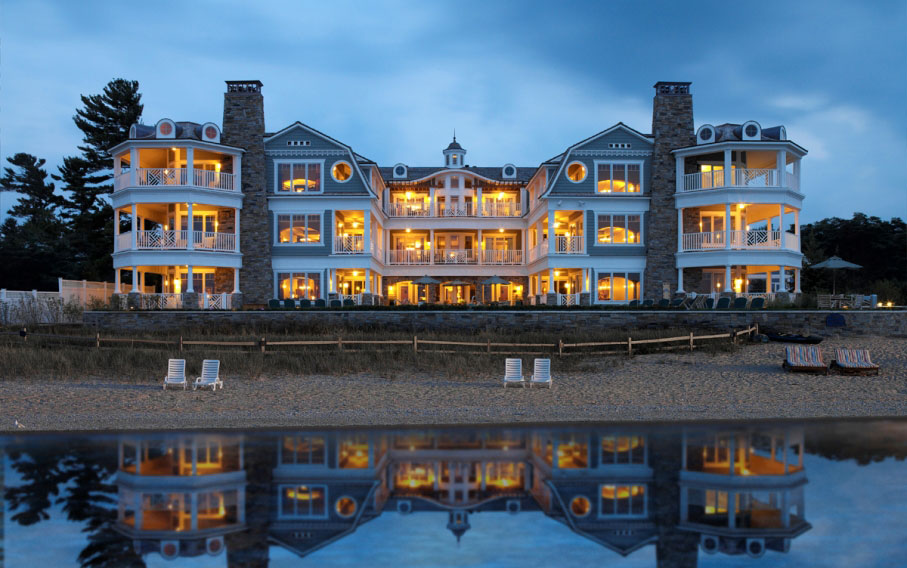
If you’re looking for family-friendly places to stay near Sleeping Bear Dunes, check out LeBear Resort in Glen Arbor! This 5-star resort offers luxury vacation rental accommodations on a white sugar sands beach and is conveniently located just minutes from the town’s fine restaurants, galleries, and shops. Each of the resort’s 14 condominium-style residences accommodates up to eight people, with three bedrooms, two-and-a-half baths, a full-size gourmet kitchen, and views of Lake Michigan, and a private balcony.
There’s a bonfire area on the beach, indoor and outdoor swimming pools and hot tubs, a fitness center with a sauna and massage therapy, complimentary Wi-Fi, and a clubhouse. During your stay, be sure to make a reservation at the award-winning on-site restaurant, Blu, where you can take in the panoramic view of the lake from inside the glass-walled dining room.
Come experience LeBear and see why the surrounding area has been called one of the most beautiful places in the US.
Learn More about LeBear Resort or Book a Reservation!
History and Geology of the Sleeping Bear Dunes
The Sleeping Bear Dunes were created at the end of the last Ice Age. Thousands of feet of ice once covered this area, part of an ice sheet that covered more than half of the North American continent. As the glaciers covering Michigan retreated between 10,000 – 14,000 years ago, the landscape that we recognize today began to emerge. As the glaciers melted, the large basins they had carved filled with water, leaving the Great Lakes of Michigan, Superior, Huron, Ontario, and Erie. The retreating glaciers also left moraines, large ridges of deposited rocks and sediment. Atop the moraines along the Lake Michigan shoreline near where Glen Arbor is today, the great perched dunes were formed as sand was blown and deposited along the ridges. Today, the Sleeping Bear Dunes reach 400 feet above Lake Michigan. The islands of North Manitou and South Manitou are visible from the shoreline.
The dunes get their name from a legend of the Ojibwa tribe (also known as the Chippewa): the Legend of Sleeping Bear. As the legend goes, a mother bear and her cubs were driven into Lake Michigan by an enormous forest fire on its western shore. They swam across the lake, with the two cubs lagging behind. Too exhausted to continue, the cubs drowned within sight of shore. The mother bear died waiting for her cubs, and the winds buried her under the sands of the dunes. Impressed by the mother bear’s determination, Manitou, or the Great Spirit, raised an island over the final resting place of each of her cubs to commemorate them.
People have inhabited the Sleeping Bear Dunes area since the Paleo-Indian period of 11,000 – 8,000 B.C.E., as evidenced by archeological discoveries such as spear points. The early inhabitants were hunters who likely passed through the area to find game close to the edge of retreating glaciers. During the Archaic Period from 8,000 – 600 B.C.E., the area became a point of trade of such goods as flint and copper, and during the Woodland Period from 600 B.C.E. – 1620 C.E., there is evidence of villages that were probably used for seasonal hunting and fishing. The area became home to the Ojibwa and Odawa (Ottawa) tribes, who along with the Bodowadomi (Pottawatomi) formed alliance known as the Council of Three Fires (or the Three Fires Confederacy). The period since 1620 is known as the Historic Era, the date marking the approximate time Europeans began making their entrance into the area.
The first Europeans to arrive were the French, who were taught by the natives how to grow maize, make birchbark canoes, and live off the land. Michigan became part of the territory of the French colony of Canada in 1668, and the French ceded it to Britain in 1763 after their defeat in the French and Indian War. After the American Revolutionary War, the 1783 Treaty of Paris expanded the United States’ boundaries to include nearly all land east of the Mississippi River and south of Canada. From 1787, Michigan was part of the Northwest Territory, until the Indiana Territory was created in 1800 to include most of Michigan. In 1805, it was separated and the Territory of Michigan was established. Michigan formally entered the Union on January 26, 1837, as the 26th state.
In 1836 and 1837, the native inhabitants entered into treaties with the US government to preserve the hunting, fishing, and gathering rights of the Council of Three Fires. The treaties were not honored by the government, however, and most of their lands were taken from them. The Odawa and Ojibwa tribes were forced on to reservations under the Ottawa and Chippewa Treaty of Detroit signed in 1855. In 1934, the Indian Reorganization Act was created with the stated purpose of preservation of native cultures and limited restoration of their rights, but applications for federal recognition by the Odawa and Ojibwa were denied in 1934 and again in 1943. It wasn’t until May 1980 that they were finally given recognition as the Grand Traverse Band of Ottawa and Chippewa Indians.
Believed to be the first non-native to settle in the Sleeping Bear Dunes area, John LaRue set up a trading post at the mouth of the Crystal River in 1848. More settlers arrived in the 1850s, including the Fisher and Dorsey families. John E. Fisher bought 1,000 acres of land on the north side of Glen Lake and gave one quiet hollow surrounded by woodlands the name of Glen Arbor. His brother-in-law, Charles C. McCarty, established a cordwood station at Glen Haven, built a 300 foot dock to service steamships, and constructed a dormitory for immigrant lumbermen. John Dorsey started a cooper shop to make fish barrels. In 1864, W. D. Burdick established a sawmill and a gristmill in the location today bearing his name, Burdickville. In 1870, the Northern Transportation Company bought Glen Haven and McCarty’s cordwood operation to serve its fleet of 24 steamships. In 1878, land developer David Henry Day arrived in Glen Arbor and within three years completed the purchase of the Company’s properties. By 1867, the township had a population of around 200 people, three docks, two hotels, four stores, a blacksmith shop, and a cooper shop.
While the core industry of the area remained lumbering, the market also expanded into tourism and agriculture. Passenger and freight steamers operated out of Glen Haven and Glen Arbor to Milwaukee and Chicago, and McCarty’s dormitory was converted into the Sleeping Bear Inn. Thousands of acres of land were dedicated for cherry and apple orchards and D. H. Day established the Glen Haven Canning Company. Day was also active in conservation efforts and served as Chairman of Michigan’s first State Park Commission. In 1920, he donated 32 acres of land along Lake Michigan between Glen Haven and Glen Arbor to the state to become the D. H. Day State Park, which is now part of the Sleeping Bear Dunes National Lakeshore.
During the severe winter of 1870-71, numerous shipwrecks took the lives of 214 people on the Great Lakes, and Congress subsequently appropriated funding for professional rescue crews under the charge of the US Life-Saving Service, which was merged with the Revenue Cutter Service in 1915 to form the US Coast Guard. As maritime traffic increased in the “Manitou Passage” between the dunes and Manitou Islands, a number of rescue stations were established in the area. The Sleeping Bear Dunes National Lakeshore includes three former Life-Saving Service/Coast Guard stations.
In 1948, a man named Pierce Stocking, who had spent his youth as a lumberman, bought woodland from D. H. Day south of Glen Haven and set up a sawmill. Appreciative of the area’s beauty, he conceived of a road that would provide visitors with access to the top of the dunes. The Sleeping Bear Dunes Park became open to the public in 1967 and was operated by Stocking until his death in 1976. A sign at the entrance to Stocking’s park read: “Take only pictures, leave only footprints.”
The idea to establish a national park in this area originated in the late 1950s, under an effort led by Senator Philip A. Hart that lasted until 1970. Its establishment was controversial as the local population was strongly opposed to the idea. As the National Park Service explains, “More than 1,400 tracts of private land had to be acquired to create the lakeshore. A heavy-handed, poorly planned land acquisition program reinforced the bitterness that surfaced during the decade of struggle that preceded authorization.”
The effort to nationalize the land won out, and on October 21, 1970, the Sleeping Bear Dunes National Lakeshore was established, spanning a 35-mile stretch of shoreline along Lake Michigan and including 21 inland lakes. In 1977, Stocking’s road became part of the national park. Several years later, due to popular demand, the road was renamed the Pierce Stocking Scenic Drive.
While the national park’s purpose is to preserve the natural features of the landscape, as buildings began to decay and be torn down, local citizens concerned about future demolitions of historic structures organized and in 1998 established Preserve Historic Sleeping Bear, a non-profit organization aimed at preserving over 300 historic structures and cultural landscapes within the National Lakeshore.
In 2014, 32,500 acres of the park were designated by the US Congress as Sleeping Bear Dunes Wilderness.
The park is located about 25 miles west of Traverse City. The villages of Empire and Glen Arbor are within the National Lakeshore and have seasonal populations that very dramatically, but a year-round population of about 378 and 788, respectively, and local economies largely dependent on tourism. Traveling the area, names like Fisher Lake, Dorsey’s Corner, and Burdickville serve as reminders of its settler history, in addition to the reminders of the native history, such as the name of the national park itself.
Jeremy loves the northern Michigan outdoors, and his hobbies include hiking, biking, exploring, and photography.


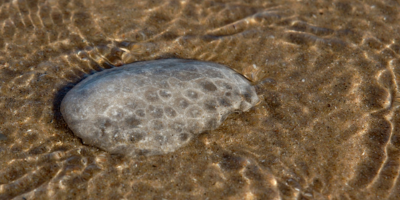
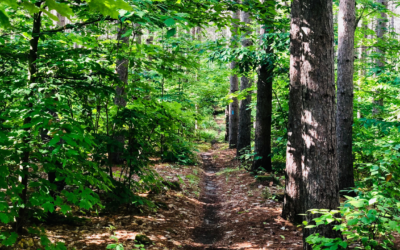

Even though I grew up in mid-Michigan, much of the history you note here was never shared with us in any classroom. I find that sad, and shortsighted given that the state is such a marvelous vacation spot, as well as filled with history, remarkable beauty, and brings so many vacationers to its shores.
Thanks for the feedback, Kathleen! We’re glad you liked the post.